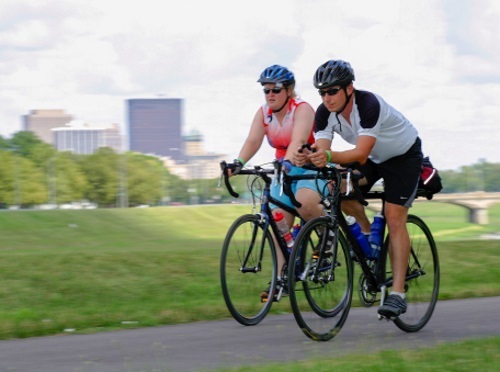The Ohio Department of Transportation has unveiled a bicycling and pedestrian “framework” to advance statewide development of active transportation over the next five years.
[Above photo by the Ohio DOT]
The agency said its new Walk.Bike.Ohio plan – constructed over the last two years based on input from local governments, other state agencies, and the public – seeks to improve mobility, safety, and quality of life as part of “equitable investments” statewide in walking and bicycling infrastructure, maintenance, programs, and policies.
“Nearly one out of every 10 Ohio households does not have access to a motor vehicle, meaning active transportation options like walking and bicycling are necessary to meet basic needs,” said Governor Mike DeWine (R) in a statement.
“When we ensure that walking and biking are safe, convenient, and accessible options – everybody wins,” he added. “The Walk.Bike.Ohio plan puts us on the right path to do that.”
The Ohio DOT noted that recent trends in safety, health, and demographics highlight what the agency called an “urgent need” for safer, accessible, and more convenient options for walking and biking in communities across the state.
In Ohio, people walking and biking make up about 14 percent of all traffic deaths, despite making up just 2.6 percent of trips to work, with “high need” populations and areas of the state experiencing a disproportionate amount – nearly double – of the severe pedestrian and bicycle crashes.
In 2020, the agency there were 164 people killed and 469 people seriously injured while traveling along or across Ohio’s roadways on foot. From 2019 to 2020 alone, pedestrian deaths increased by 30 percent, with the most notable increases occurring at intersections with unmarked crosswalks (up 600 percent), at unmarked, mid-block locations (up 84 percent), and in circumstances involving speed (up 60 percent).
“Although the publication of Walk.Bike.Ohio is a major milestone for Ohio, it is just the beginning of the work necessary to achieve our vision,” said Jack Marchbanks, Ohio DOT’s director.
For example, an economic impact analysis completed as part of this effort found that existing trips by foot or bike could save Ohioans $12.7 billion in transportation and environmental costs over the next 20 years. Furthermore, in walking and biking rates increase by just over 1 percent statewide, an additional $5 billion in cost savings over the next two decades.
In addition to economic benefits, connected active transportation networks can also play a role in improving Ohio’s ranking of 40th in the United States for overall health outcomes and 47th for health behaviors, which include obesity and physical inactivity.
The Ohio DOT active transportation plan is also an “opportunity” to address growing mobility “needs and preferences,” the agency said. In 1983, about 46 percent of 16-year old Americans had a driver’s license, according to the Federal Highway Administration. By 2014, that number had dropped to just over 24 percent. In Ohio, the number of 16- and 17-year old drivers fell from 84,985 in 2016 to 70,678 in 2020.
Additionally, as the share of Ohio’s population over 65 continues to grow, more state residents may rely on or prefer transit and active transportation options, the Ohio DOT noted.
The hope, said the agency, is that its five-year active transportation plan will serve as a “useful tool” for decision-makers at all levels of government in Ohio as they look at ways to make the state more walkable and bike accessible. “The development of Walk.Bike.Ohio has helped us to establish a statewide vision for walking and biking, informed by practitioners and the public,” Caitlin Harley, Ohio DOT’s active transportation manager. “This plan outlines what Ohio DOT will seek to advance over the next five years in order to improve walking and biking as a transportation option in Ohio.”
